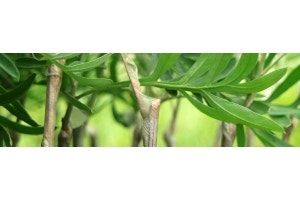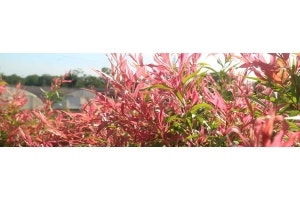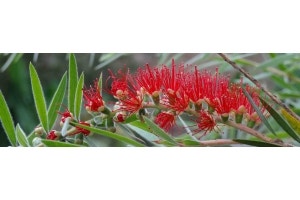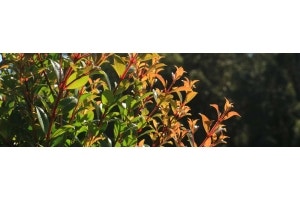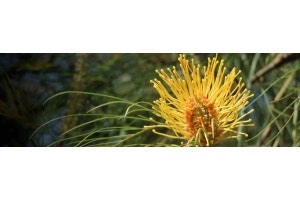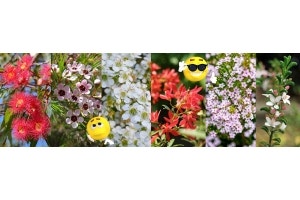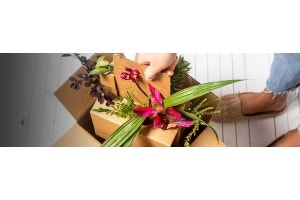
What is one of the most popular shades of plants we offer, and Pantone Colour of the Year in 2018?
Yes, this week, like the late lamented Prince himself, we're Pashing on Purple.
You'll discover some of our favourite amethyst-berry-grape-lavender-lilac-magenta-mauve-plum-violet-and-wine-coloured flowering plants. Which one is your favourite?
Purple can be rich, dark, moody; or nostalgic, pale, feminine. From the inky darkness of agapanthus, and the vibrant magenta of tibouchina, to the warm mauve of honey myrtle, and delicate lilac of crepe myrtle, there's a purple to suit every garden colour scheme.
Some of the easiest to grow, lowest-maintenance flowers for our gardens also flower in purple. Like these easy-care purple plants : free-flowering society garlic, resilient grassy liriope, reliable and popular agapanthus, and butterfly-favourite buddleia, aka the butterfly bush.Purple flowers are also favourites of bees, as their eyes are adapted to see the colour easily. So if you want to help our vulnerable native bee populations survive, tucking one or two purple plants into your garden borders is a great way to start!
Purple For the Rich and Ruling Class
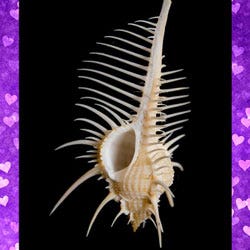
Did you know? Purple was originally a colour reserved only for the very powerful - or the very wealthy.
One of the earliest purple dyes came from a Mediterranean sea snail, prevalent around Tyre in Syria; the blood-red-purple produced from the snail was known as Tyrian purple.Thousands of molluscs, harvested at the perfect time of year, were needed to colour your best Roman ceremonial toga, Phoenician legal cloak, or Byzantine imperial gown.
It was a stinky business, but a lucrative one. Unlike plant-based dyes which faded in light or when laundered, the snail's intense colour became stronger.
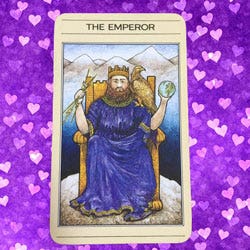
Because of its scarcity and expense, Tyrian Purple became a status symbol, and later a power symbol.
Use of this valuable colour was restricted in Roman times to senior members of the law and the military, and then only for certain occasions.Inevitably, purple was appropriated by the Roman emperor for his exclusive use. As a result the colour - a strong warm tone closer to what modern eyes would call magenta - became associated with authority and leadership.
You don't have to be an emperor to enjoy glorious Tyrian purple colour - buddleia Royal Red, cuphea Golden Ruby, native honey myrtle, and Centradenia Spanish shawl will give you that pleasure for pennies.
It's a luxurious shade, full of intensity, and it pairs very well with golden-leaved plants which enhance its vibrant depth of colour.
Purple For the Religious and Royal
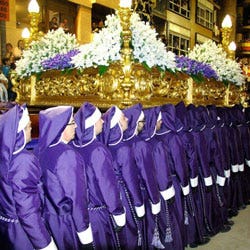
Spanish Catholics observe Holy Week with special purple robes; and Anglican clergy wear purple in Lent.
Website simplycatholic says"the use of purple attire by bishops was originally intended to show that the bishops possessed religious and spiritual authority equal to the temporal and civil authority of princes and kings."So purple became a colour fit for kings and queens, judges and generals, bishops and bigwigs. A very powerful, important colour!
 Give your garden the ecclesiastical stamp of authority with lush mop-head hydrangea, honey-sweet scented Brunfelsia, known as yesterday-today-tomorrow, as its flowers change from purple to lilac to white with age; hebe, which bees and other beneficial pollinators adore; and vibrant tropical tibouchina, blooming in all shades of regal purple.
Give your garden the ecclesiastical stamp of authority with lush mop-head hydrangea, honey-sweet scented Brunfelsia, known as yesterday-today-tomorrow, as its flowers change from purple to lilac to white with age; hebe, which bees and other beneficial pollinators adore; and vibrant tropical tibouchina, blooming in all shades of regal purple.
Purple For the Masses
It wasn't until the 1800s that an artificial, vegan-friendly purple dye was produced, called aniline purple or mauveine.
Inventor William Perkin, aged only 18, was trying to produce a cure for malaria - and instead produced a bright vivid purple, which sparked an instant fashion craze for the colour.Charles Rees, Fellow of the Royal Society of Chemistry, wears a bowtie dyed with mauveine.
Celebrate world-changing surprises and Edwardian colour crazes by making room for bright mauve in your garden. Wear a bowtie while you plant, why not?
True Blue Purple
If you're a True Blue Aussie you can still love purple (and it doesn't have to be the maroon of Queensland!)There are many Australian native purple plants can bring Perkin's luminous colour to your back yard. You could start a new mauveine craze in your neighbourhood! Plant Australian indigo, Melastoma or bluetongue, happy wanderer, a scrambling climber also known as purple coral pea, and the easy-care groundcover fanflower to start. And there are many more native plants that fly the green-and-gold for purple - like the very popular native violet, white with a dark grape-purple centre; and purple-leaf foliage plants hop bush and acacia below.
Quintessential Purple
We can't talk about purple plants without talking about three in particular that are so beloved, they have given their name to shades of purple.
That's lavender, lilac, and violet.
Purple All Year Round
Pashing on Purple doesn't mean restricting yourself to flowering plants - there's plenty of purple-leaved plants to give your garden rich colour all year long. Two of our best-selling groundcover plants, Alternanthera Little Ruby and Loropetalum Purple Pixie, prove how popular purple plants are in Aussie gardens. Plant them in dappled shade for deep plum tones, plant them where the sun can shine through for glowing burgundy wine shades.
Strobilanthes, commonly known as goldfussia, has deep wine-coloured leaves and very pale lilac flowers - a double dose of purple! The leaves of Barleria Purple Gem are splashed in plum and lilac shades; while purple waffle leaves are maroon above, magenta below, especially when the sun shines through. And many heucheras and heucherellas have richly-coloured purple leaves, from soft dusky shades to intense vintage wine.Native Cootamundra wattle has a purple-leaved form - Acacia baileyana purpurea - that shimmers in dark amethyst shades; native sticky hop has a purple-leaved form that glows in tones of burgundy; Vitex flashes its lilac-leaf-undersides when the breezes blow; and rhoeo proudly displays its magenta purple reverse, contrasting with the deep green upper leaf.All this beautiful purple reminds us of one of our favourite poems, by the poet Jenny Joseph, which begins
"When I am an old woman I shall wear purple
With a red hat which doesn’t go, and doesn’t suit me.
And I shall spend my pension on brandy and summer gloves
And satin sandals, and say we’ve no money for butter."
Happily, whether we're prince or pauper, we gardeners can enjoy this most majestic of colours in our own little kingdoms, our back yards. Where can you find a place for purple in your outdoor space?
































